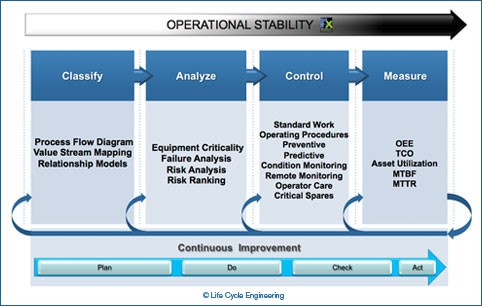Thomas Jefferson University Hospitals is a leading academic medical center in Philadelphia dedicated to excellence in patient care and safety. The hospitals are part of the Jefferson Health network that includes 14 hospital locations, seven urgent care centers, one NCI-designated cancer center, 22 rehab specialty services, 19 outpatient centers and 25 testing and imaging centers.
Hospital System Goal: Improving Equipment Reliability Using a Risk-based Asset Management Approach

Thomas Jefferson University Hospital (TJU) wanted to develop and sustain a successful reliability program. Program goals included improving Thomas Jefferson University equipment reliability, reducing unplanned equipment downtime, and reducing maintenance costs, using a risk-based asset management approach. This reliability program was intended to serve as the foundation for a larger asset management program being developed.
Initial, specific target objectives of the reliability program included:
- Reduce maintenance costs by predicting, planning and properly fixing issues to minimize unplanned incidents which caused uncontrolled spikes in spending
- Improve safety and regulatory compliance (resulting in fewer breakdowns and less impact on patients)
- Maximize lifecycle to better manage and plan capital spending
The TJU Facilities Management team had established a Steering Committee to define the critical success factors and evaluate limitations such as funding / resources and the organization’s willingness to change. The committee was ready to hire an independent consultant to help define the current and future states for the reliability program.
Creating a Reliability Program Begins with Assessing the Current State of Reliability and Asset Management
TJU partnered with Life Cycle Engineering (LCE) to kick off the Reliability Program and apply a proven Risk-Based Asset Management (RBAM®) strategy. This approach focuses on prioritization of assets based on their impact to key business objectives, and allows for the most effective use of available resources
LCE conducted an audit to analyze the current state of TJU’s Facilities Operations & Maintenance department, focusing solely on a large hospital building as a pilot for the project. The strategies derived from the pilot had to be applied to all regions and buildings regardless of function. LCE’s audit compiled data from observations made during the site tour, personnel interviews, and through evaluation of existing processes and procedures.
The audit consisted of an assessment process divided into three parts, the Reliability Excellence® (Rx) Assessment, the Asset Management Capability Assessment, and the Project Change Triangle Assessment.
The Reliability Excellence Assessment is an evaluation of LCE’s 29-element Rx Model, in which each element is ranked and used to calculate an overall score. The score is used as a baseline to indicate the current state of the organization, with an organization’s overall rating shown along a 0 to 1000 point scale with correlated levels growing from Reactive, to Emerging, Proactive, and Excellence. The overall score enables the organization’s leadership to envision the path to improvement, and determine a goal they want to achieve. For TJU, the initial assessment revealed an overall score of 402, in the Emerging stage, just above Reactive. TJU’s goal was not to achieve an Excellence score, but to evolve to a Proactive score. Leadership determined that this was the optimum level to be cost-effective, achievable within five to seven years, and maintainable over the long term.
The Asset Management Capability (AMC) Assessment evaluates the asset management program with over 50 process criteria categorized into domains, including Leadership & Strategy; Shutdown, Turnaround, & Outage (STO) Management; Operator Driven Reliability; Materials Management; Work management; Reliability Engineering; Capital Delivery; and eAM/CMMS.
The Project Change Triangle (PCT) Assessment is used to evaluate how well the changes that will be made as part of the prior assessment models will be managed by the organization. This model is proprietary to Prosci®, and the assessment effort was led by LCE. The categories evaluated are Leadership/Sponsorship, Project Management, and Change Management.
The assessment results provided an accurate picture of the organization and recommended actions that would help TJU achieve the Proactive status as a result of its Reliability Improvement program. To drive the needed changes and complete the key improvement activities, TJU tasked its Steering Committee with deciding what initiatives to take on. The Leadership Team was responsible for the approval and funding of the strategies proposed by the Steering Committee, and the Focus Team was tasked with completing the activities developed by the Steering Committee.
Reliability Program Pilot Creates the Foundation for Organization-wide Improvements
With the assessment results in hand, LCE partnered with TJU to implement a Risk-based Asset Management (RBAM) approach to focus improvement activities on assets based on their impact to key business objectives, and allow for the most effective use of available resources.

To ensure that TJUH implemented a sustainable program, LCE recommended and followed six steps to apply the RBAM approach and accomplish the pilot phase of their program:
Step 1: Education & Change Management
Risk-Based Asset Management training to raise awareness and obtain sponsorship, support and employee engagement
Step 2: Classify
Reliability Excellence and Asset Management Capabilities Assessment, Project Change Triangle Assessment
Reviewed asset data, hierarchy and system criticality
Step 3: Analyze
Based on criticality, conducted failure mode and effects analysis (FMEA), PM optimization and asset condition assessment
Step 4: Control
Developed equipment maintenance plans and risk monitoring/controls (e.g. PMs, PdM, Operations care, monitoring, etc.)
Step 5: Measure
Established reliability measures and key performance indicators (KPIs) for asset availability, uptime and utilization
Step 6: Continuous Improvement
Established monitoring and trending of reliability KPIs and developed Reliability Playbook/Policy
The Reliability Program pilot established the foundation that the TJU Reliability Steering Team has used to create and expand a scalable reliability program for all hospital and university facilities.
About LCE
Life Cycle Engineering (LCE) provides consulting, engineering, information technology and education solutions that deliver lasting results for private industry, the Department of Defense and other government organizations. The quality, expertise and dedication of our employees enable Life Cycle Engineering to serve as a trusted resource that helps people and organizations to achieve their full potential. Founded in 1976, LCE is headquartered in Charleston, South Carolina with offices across North America and experience around the globe. Follow us on LinkedIn, Twitter and YouTube for company updates.

To learn more about LCE’s Asset Management Consulting services,
please visit our website.















